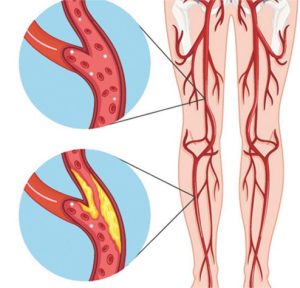By Dr. Altepeter
 Peripheral arterial disease (PAD) is a relatively common condition that affects over 200 million people worldwide, and involves narrowing of arteries to the arms or legs. It is a disease process that can cause significant day to day limitations for those affected, with risk and prevalence increasing with age. It does have a very close relationship with cigarette use, high cholesterol, diabetes, coronary and renal artery disease, stroke, and heart failure. In over three-quarters of those with symptomatic PAD, the lower extremities are affected.
Peripheral arterial disease (PAD) is a relatively common condition that affects over 200 million people worldwide, and involves narrowing of arteries to the arms or legs. It is a disease process that can cause significant day to day limitations for those affected, with risk and prevalence increasing with age. It does have a very close relationship with cigarette use, high cholesterol, diabetes, coronary and renal artery disease, stroke, and heart failure. In over three-quarters of those with symptomatic PAD, the lower extremities are affected.
An analogy routinely used to portray PAD, albeit imperfectly, is congestion on the roadways, with the vehicles being oxygen and nutrient rich blood cells, and arteries being the roads. Vehicles are able to travel much more efficiently in the larger, open roadways, but once there is a sudden lane closure they have to slow down in order to pass through. When the muscles of the legs are working hard, the need for those nutrients carried in the blood increases, making it more important for vehicles to make it to their destination efficiently. When there is a roadblock, muscles or tissues that are not receiving the blood flow they need for normal function begin to cry out in various ways. Muscle cramps, foot pains, and burning or numbness are some of the symptoms that one with PAD may be experienced during activity. These symptoms can be known collectively as “intermittent claudication” when experienced after a predictable amount of activity. And this is one of the earliest symptoms a patient could experience as they suffer from PAD. As the disease process worsens, the legs or feet may cry out for nourishment regardless of activity. When cramping, numbness, or burning are noted at times of rest, it is known as “rest pain.” Without appropriate management one may begin to experience slow healing sores, tissue loss, or “gangrene” when there is little to no blood flow to an area. Fortunately, the majority of those who have been diagnosed with PAD are largely symptom free, and have a better chance of remaining symptom free if managed appropriately.
If you are experiencing some of the above symptoms, or are concerned you are at risk of developing PAD, it is important to seek medical advice sooner than later. In addition to a discussion about risk factors, some of the more simple tests to expect with evaluation would include palpation of arteries near your hip, behind your knee, and around your foot and ankle, visualization of how quickly capillaries refill after pressure is applied, and listening to pulses with an ultrasound device, among others. If there are risk factors or additional concern for disease, additional tests may be ordered such as special blood pressure measurements known as an ankle-brachial index and more advanced measurements with ultrasound, and some advanced imaging modalities such as magnetic resonance or computed tomography studies. And if deemed necessary by a peripheral vascular specialist, angiography, or mapping of the arteries, may be performed for a more thorough evaluation of any problem areas.
If diagnosed, your doctors will advise smoking cessation, an appropriately balanced diet, strategize better control of other medical conditions, and appropriate foot and skin care. You may be also recommended an exercise program to help stimulate better blood flow, medications to help blood flow more efficiently or to prevent clotting, or possibly surgical management. These are best accomplished with your primary care physician, vascular surgeon, foot and ankle specialist, and any other specialists working as a team.
Disclaimer: This content is not intended to be a substitute for professional medical advice, diagnosis, or treatment. Always seek the advice of your physician or other qualified health care provider with any questions you may have regarding a medical condition.
Joe Altepeter, DPM, AACFAS, is a Podiatrist at Family Foot & Leg Centers in Fort Myers FL. He is a Fellow of the American College of Foot & Ankle Surgeons. Call 239-430-3668 or visit www.NaplesPodiatrist.com to make an appointment. Visit FootHealthFacts.org to learn more about foot and ankle conditions.
Joe Altepeter, DPM, AACFAS
1645 Colonial Blvd.
Fort Myers, FL 33907
(239) 430 – 3668 (FOOT)
www.NaplesPodiatrist.com









